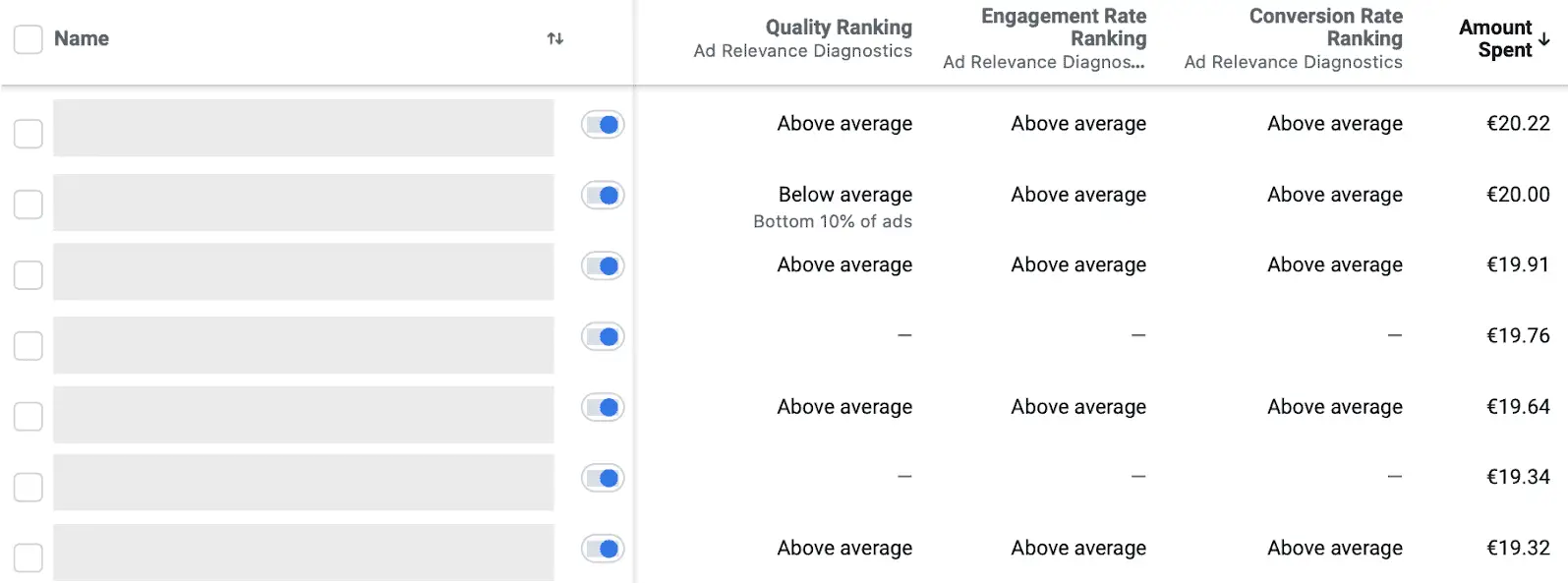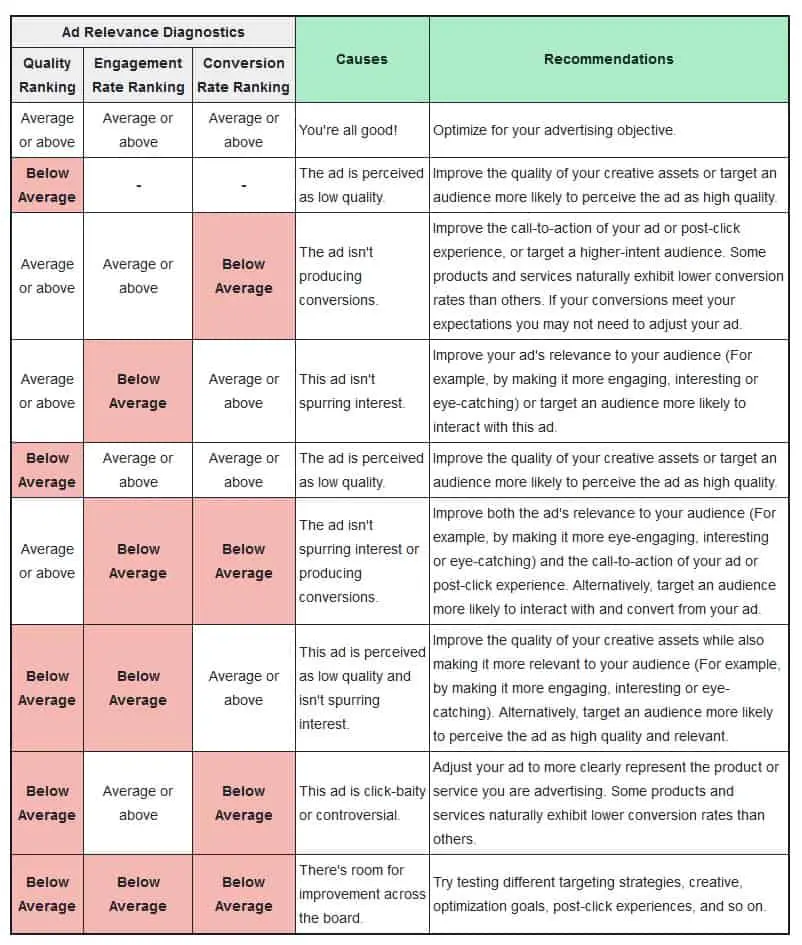Facebook relevance is no longer relevant. The single-score approach has been abandoned and replaced with the new quality ranking. The Facebook relevance score helped estimate it to your target group. This score is created by drafting your ads based on the audience’s negative and positive feedback. The input determines your score update, given a range of 1-10. However, only ads generated over 500 impressions are legible enough to receive the score.
In the last article, we showed how to find contacts on Facebook , and in this one, we will analyze the quality of Facebook ads.
, and in this one, we will analyze the quality of Facebook ads.
Facebook Ad Quality Ranking
Facebook Ad Quality Ranking is a diagnostic tool that offers insights into the quality of your ads. It’s part of ad relevance diagnostics, including engagement and conversion rate ranking.
The quality ranking assesses your ad’s perceived quality compared to ads competing for the same audience. This is determined by various factors, such as feedback Facebook expects from people viewing your ad and how it performs beyond its intended audience. The quality score can be above average, average, or below average (which can be further divided into the bottom 35%, 20%, or 10%).
Here’s what the ranking values mean:
- Above Average: Your ad’s perceived quality exceeds 55% – 100% of ads competing for the same audience.
- Average: Your ad’s perceived quality is in the middle, with 35%-55% of ads competing for the same audience.
- Below Average (Bottom 35%): Your ad’s perceived quality is lower than at least 65% of ads competing for the same audience.
- Below Average (Bottom 20%): Your ad’s perceived quality is lower than at least 80% of ads competing for the same audience.
- Below Average (Bottom 10%): Your ad’s perceived quality is lower than at least 90% of ads competing for the same audience.
If your quality ranking is low, it may be because your audience doesn’t find your ad relevant, your ad’s content may be of low quality, or you may be using practices like clickbait or engagement bait, which are discouraged by Facebook. It’s essential to improve the quality of your ad content, targeting, and practices to improve this ranking and overall ad performance.
This compares your ads with the ones in the same group of a particular audience. Once comparisons have been made, you will be ranked based on your ads’ reaction to the ones of your competitors.
You want to know how Facebook ranks based on the audience, right? However, before I clear up on that, I should caution you not to think that reactions and reporting or even sharing the ads are being used when doing this calculation.
Facebook uses data from hidden ads by asking why they were hidden. In addition to such feedback, it will access related engagement bait and clickbait.
How to Improve Facebook Ad Quality Ranking?
- Target the Right Audience: Ensure your ad is relevant to your target audience. Irrelevant ads can lead to poor engagement and a lower quality ranking.
- Use High-Quality Visuals: Always ensure your images and videos are of the highest quality. Poorly designed visuals or low-resolution photos can lead to a lower quality ranking.
- Optimize Ad Copy: Write compelling, clear, and concise ad text. This is your chance to communicate the value of your product or service to your audience. A/B test different ad copy to see what resonates best with your audience.
- Follow Facebook’s Ad Policies: Adhere to Facebook’s advertising policies. Advertisements that violate these policies can receive a lower quality ranking or even be disapproved.
- Avoid Clickbait Tactics: Don’t use misleading or exaggerated headlines to entice users to click on your ad. Facebook penalizes clickbait techniques, which can lead to a lower quality ranking.
- Test Different Ad Formats: Facebook offers various ad formats, including carousels, single images, videos, and more. Try different formats to see what works best for your audience.
- Update Ads Regularly: Avoid ad fatigue by refreshing your ad creative regularly. Using the same ad for an extended period can lead to audience fatigue and lower engagement.
- Use User-Generated Content: User-generated content can often feel more authentic and relatable, leading to higher engagement and a better quality ranking.
- Monitor and Respond to Comments: Responding to comments on your ad can increase engagement and show that your brand values customer feedback.
- Avoid Too Much Text on Ad Images: Facebook prefers ad images with less text. Too much text on your ad images can lead to reduced delivery and a lower quality ranking.
In my opinion, the most important tactics for improving Facebook’s Quality ranking are targeting the right audience and creating a clear, understandable ad message and image that matches landing page content.

Let’s dive a bit deeper into these strategies:
- Targeting the Right Audience: The Relevance of your ad significantly impacts its quality ranking. If you’re showing your ad to people who aren’t interested in your product or service, they’re less likely to engage with it, which can negatively affect your ranking. Therefore, it’s essential to understand who your customers are and use this information to target your ads effectively. This might include targeting based on location, age, gender, interests, behaviors, or a combination. Facebook’s Custom Audiences and Lookalike Audiences can also help you reach the most relevant people.
- Creating a Clear, Understandable Ad Message and Image: Your ad’s content plays a significant role in its success. Your message should be clear and compelling, immediately conveying what you’re offering and why it’s of value. A confusing or overly complex ad can deter potential customers. Additionally, your ad’s visual component (image or video) should be high-quality, attention-grabbing, and relevant to your message. As much as possible, try to show your product or service in use to help potential customers visualize its benefits.
- Matching Ad Content with the Landing Page: When users click on your ad, they should land on a page that matches the expectations set by the ad. If there’s a disconnect, users will likely leave immediately, hurting your conversion rate and negatively impacting your ad’s quality ranking. Therefore, ensure your landing page aligns with your ad’s design, messaging, and offer. For instance, if your ad promotes a specific product or deal, the landing page should focus on that product or deal, not just your homepage or a generic category page.
All these tactics contribute to a positive user experience, which Facebook’s ad quality ranking aims to measure. By prioritizing these strategies, you’re likely to see an improvement in your quality ranking and overall ad performance.
There have been mixed reactions to what this change will bring, and today, I have chosen to share what quality ranking is all about. I know you would love to see the impact that it will have on your ads because you may have been battling low scores for an extended time before we embarked on the main subject. It is essential to make it clear that the relevance score has become outdated in meeting the needs of most users.
The downside of this score is that it doesn’t give directions on improving a low score. In addition, you will not know why you are getting the low score because it doesn’t know where the problem is, so you will be left guessing if it is the target audience, the ad itself, or the conversion you are bidding for.
Most people have a misconception that you will not get results if you have low ratings on your ads. However, that is not the case because, still, with the low score on the ads, you will get results that are only an indication for you to put in more effort.
Facebook has played a crucial role in helping you assess your performance by embracing the current diagnostics. These metrics are used to determine ad value, the expected conversion rate of the ad, and engagement. With such a scope, you can quickly identify which needs extra attention.
Engagement Ranking
This ranks your ads based on the engagement of the ads competing with the same target group. This speculates how your audience will comment, react, share, and expand the ad. A well-designed, clear ad is suitable for elevating your engagement ranking. However, it would help if you were cautious about attaining your ranking.
Facebook Conversion Ranking
Conversion Rate Ranking is a component of Facebook’s ad relevance diagnostics. It assesses how your ad’s expected conversion rate (how often Facebook predicts your ad will lead to your optimization goal) compares with advertisements with the same goal and competing for the same audience.
Here’s a further breakdown of what these rankings mean:
- Above Average: This ranking means that the conversion rate of your ad is in the top 20% of ads competing for the same audience with the same optimization goal.
- Average: An “average” ranking means your ad’s conversion rate is in the middle of 60% of ads competing for the same audience with the same optimization goal.
- Below Average (Bottom 35%): This ranking means your ad’s conversion rate is lower than 65% of ads competing for the same audience with the same optimization goal.
- Below Average (Bottom 20%): This ranking means your ad’s conversion rate is lower than 80% of ads competing for the same audience with the same optimization goal.
- Below Average (Bottom 10%): This ranking means your ad’s conversion rate is lower than 90% of ads competing for the same audience with the same optimization goal.
Note that a low conversion rate ranking may indicate that your ad’s call to action or the post-click experience isn’t driving people to complete valuable actions. Therefore, these areas may need improvements to increase the conversion rate. It’s also essential to ensure the ad’s content is relevant and appealing to your target audience to optimize conversions.
Facebook Relevance diagnostic
Facebook’s ad relevance diagnostics tool is used to help advertisers understand their ad’s performance and identify areas of improvement. The tool breaks down ad performance into three separate metrics: quality ranking, engagement rate ranking, and conversion rate ranking. These metrics are compared to other ads competing for the same audience. Here’s a detailed guide on how to use this tool and improve these rankings:
- Quality Ranking: This measures the perceived quality of your ad compared to ads competing for the same audience. It is affected by the overall quality of your creative, any feedback Facebook receives on your ad, and how relevant your audience finds your ad.
- Improving Quality Ranking: To improve this ranking, you must focus on making your ads as high-quality as possible. This includes ensuring your images or videos are high-resolution and your ad copy is well-written, engaging, and error-free. Using user-generated content can also increase ad relevance. Always respect Facebook’s ad policies and guidelines to avoid negative feedback. Lastly, make sure your ad is relevant to your target audience. If your quality ranking is consistently low, you might need to revisit your audience targeting strategy.
- Engagement Rate Ranking: This metric predicts how your ad will perform in terms of engagement (likes, clicks, shares, and comments) compared to other ads targeting the same audience.
- Improving Engagement Rate Ranking: To improve your engagement rate, make sure your ad is engaging and likely to prompt action. This could mean creating compelling headlines, using solid calls to action, and choosing images or videos that catch the viewer’s attention. Encourage viewers to interact with your ad by asking a question or asking them to share their thoughts in the comments. Experiment with different ad formats (videos, carousels, etc.) to see what your audience prefers. Utilize A/B testing to find out what works best.
- Conversion Rate Ranking: This predicts how your ad will perform in conversions compared to other ads with the same optimization goal and audience.
- Improving Conversion Rate Ranking: To boost this ranking, ensure your ad leads to a seamless and relevant landing page. The landing page should match the ad’s offer and messaging, and it should be easy for users to complete the desired action, whether making a purchase, signing up for a newsletter, or filling out a form. Make sure your call to action is clear and persuasive. If your conversion rate ranking is consistently low, you might need to reconsider your ad’s offer—is it compelling and valuable enough to prompt action?
Remember, monitoring these metrics regularly and adjusting your strategy accordingly is crucial. Don’t hesitate to test a new approach if an ad isn’t performing well despite your best efforts. Use the information the ad relevance diagnostics tool provides to your advantage to create better ads and improve your Facebook advertising strategy.
If your advertisement is not performing as well as expected, please do not worry! All you need to do is check the following sections, where you will reveal detailed insights on SD relevance diagnostic.
A brief overview of ad relevance diagnostic on Facebook
As mentioned earlier, you can quickly diagnose underperforming ads using ad-relevance diagnostic metrics on Facebook. This program helps you identify whether an ad is relevant enough to meet its advertising objectives. Please note that pertinent high advertisements are often correlated with high-performing ads. But, for those ads that have already fulfilled the targets and met your advertising objectives, you may not need to use ad relevance diagnostic in such cases.
But when your ad isn’t performing well enough or has failed to meet your advertising objectives, you can take advantage of this program and make the required adjustments. For example, factors like post-click experience, engagement rate, ad quality, and audience targeting play a significant role in creating well-performing and well-relevant ads. These factors also collectively help improve the quality ranking of your advertisements on Facebook.
Are you interested in improving your advertisements’ Facebook quality ranking? If so, please keep reading and provide more details about this topic in the following sections.
Critical factors of ad Relevance diagnostics program

- Quality Ranking:
- If above average or average: This implies the ad performs well and is high quality.
- If below average, it indicates a low-quality ad, necessitating improvements to creative assets or adjustments to the target audience.
- Engagement Rate Ranking:
- If above average or average: Your ad is exciting and engaging for the audience.
- If below average: Your ad may be perceived as boring, necessitating a more engaging, relevant, and eye-catching approach.
- Conversion Rate Ranking:
- If above average or average: Your ad is effectively leading to conversions.
- If below average: The ad isn’t generating sufficient conversions, implying a need to improve call-to-actions, post-click experiences, or adjust the target audience.
- Quality and Engagement Rate Rankings below average:
- This situation requires making the ad more relevant and engaging for the audience and considering a shift to an audience that values your ads’ quality more.
- Quality and Conversion Rate Rankings below average:
- This situation could imply that your ad is controversial or clickbait. Adjusting the ads to represent the product or service appealingly and engagingly more accurately is essential.
- Engagement Rate and Conversion Rate Rankings below average:
- This situation requires efforts to make the ad more engaging and exciting and improve the call-to-action to persuade customers to interact with your ad.
- All three rankings are below average:
- This situation indicates a significant need for improvement in your ad. Strategies could include defining creative optimization goals, improving post-click experiences, and adjusting the targeting strategy.
Tips to Improve Facebook Score
- Test Different Ad Formats
Different ad formats appeal to other types of audiences. Some formats you can use are static images, carousels, videos, and slideshows. Monitor the ad scores for various formats to identify which resonates best with your target audience.
- Use A/B Testing
Create two variations of your ad (Ad A and Ad B) and test them against each other to see which performs better. This will help you understand what works and what doesn’t for your audience and allow you to optimize your ads effectively.
- Update Ads Regularly
To maintain interest and engagement, regularly update your ads with fresh content. Ad fatigue is real and can hurt your ad’s performance over time. Constantly introducing new creatives can help maintain a high ad score.
- Optimize for Mobile
With increasing Facebook users accessing the platform via mobile devices, ensure your ads are optimized for mobile viewing. This can significantly enhance your ad’s performance and relevance score.
- Craft Compelling Ad Copy
The text accompanying your ad is just as important as the visual creative. Craft compelling, clear, concise ad copy that immediately grabs attention and encourages action.
- Monitor and Respond to Comments
Engaging with your audience can boost your ad’s Relevance and engagement score. Monitor comments on your ads and respond promptly and appropriately.
- Use High-Quality Images and Videos
Poor-quality visuals can negatively impact your ad score. Always use high-quality images and videos professionally edited and designed to capture attention.
- Include a Clear Call to Action (CTA)
Every ad should guide viewers toward a specific action, such as visiting your website, signing up for a newsletter, or purchasing. Clear CTAs can significantly increase engagement and conversion rates, improving your ad score.
Conclusion
I hope the information in this article has shed some light on your path to success. This knowledge will help you appreciate Facebook’s new quality Ranking. You are in an excellent position to know what prevents you from scoring well on your ads. It is also essential to see the audience’s behavior in your target group. Know their expectations and interest in developing quality content that will meet their needs.
If your ad already fulfills your advertising objectives, performing an ad relevance diagnostic may not be necessary! However, in such cases, when your ads can’t meet your advertising goals, you should closely analyze the parameters like quality ranking, engagement rate ranking, and conversion rate ranking. Then, based on the scores of these three parameters, you should take adequate action. In this way, you can successfully optimize your advertising objectives.
Finally, it is your turn to work on your ads because your success depends on your efforts and commitment.
- Facebook Ads to Get Followers! - December 27, 2024
- ClickUp vs. Slack - December 20, 2024
- Mastering E-Commerce Analytics: A Blueprint for Success





